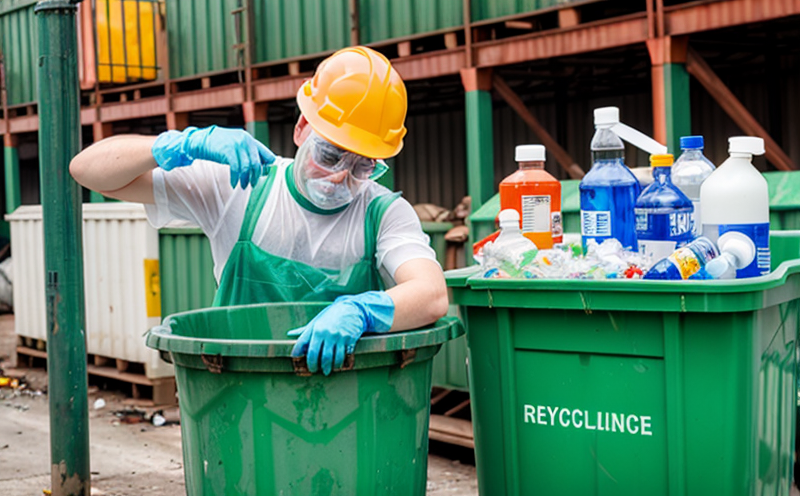AOAC 2007 Pesticide Residue Testing in Waste Foods
The AOAC (Association of Official Analytical Chemists) Method 2007.01 is a widely recognized standard for the determination of pesticide residues in waste foods. This method ensures that food waste, which may be destined for recycling or composting, does not contain harmful levels of pesticides that could compromise safety and environmental integrity.
This testing procedure is crucial for ensuring compliance with regulatory standards set by agencies such as the Environmental Protection Agency (EPA) and Food and Drug Administration (FDA). The method involves several steps including sample preparation, extraction of residues using organic solvents, clean-up procedures to remove interfering compounds, and finally, analysis via gas chromatography coupled with mass spectrometry (GC-MS).
The AOAC 2007.01 method is designed to identify over 350 different types of pesticides across various food categories. It can detect both organophosphates and carbamates which are common pesticide classes used in agriculture but also present in waste streams from industrial processing facilities.
For accurate results, it’s important that the samples undergo rigorous pre-treatment steps to eliminate interfering substances like fats, proteins, or other complex matrices. This ensures reliable quantification of the target analytes without interference from matrix components.
The significance of this testing cannot be overstated, especially given increasing emphasis on sustainable practices within the waste management industry. By ensuring that food waste materials do not contain harmful residues, we contribute towards reducing contamination risks in recycling processes or composting operations.
Accurate identification and quantification of pesticide residues through AOAC Method 2007 help protect public health while supporting environmentally responsible disposal methods for agricultural by-products.
Scope and Methodology
| Step | Description |
|---|---|
| Sample Preparation | Initial step involves grinding the waste food sample into a fine powder, followed by homogenization in extraction solvent. |
| Extraction Solvent | Aqueous solution of methanol and water is used for extracting pesticide residues from the ground sample. |
| Cleanup | Pesticide extract undergoes cleanup steps to remove fats, proteins, and other interfering materials using solid phase extraction cartridges. |
| Analysis | The purified extracts are analyzed by GC-MS for identification and quantification of pesticide residues. |
This standardized procedure ensures consistent results across different laboratories conducting this type of analysis. The use of specific solvents, cleanup techniques, and analytical instrumentation is critical to obtaining accurate data on pesticide residue levels in waste foods.
Why Choose This Test
The AOAC 2007 Pesticide Residue Testing method offers several key advantages when it comes to ensuring the safety of recycled food products:
Regulatory Compliance: Ensures adherence to international standards like ISO, ASTM, and EN.
Rigorous Validation: The test has been validated against numerous pesticides found in both agricultural produce and industrial waste streams.
Confidence in Results: With multiple laboratories worldwide using the same methodology, there is high consistency in results across different jurisdictions.
Supports Sustainability Initiatives: By ensuring that food waste destined for recycling or composting does not contain harmful residues, this test supports sustainable practices in agriculture and waste management industries.
The AOAC 2007 method provides peace of mind to quality managers, compliance officers, R&D engineers, and procurement teams who are responsible for ensuring that their operations comply with strict regulatory requirements. It also allows companies involved in the food industry supply chain to demonstrate their commitment to sustainability.
Competitive Advantage and Market Impact
By implementing AOAC 2007 Pesticide Residue Testing, organizations can gain significant competitive advantages within their respective markets:
Increase Customer Trust: Demonstrating adherence to stringent testing protocols boosts trust among consumers who value food safety.
Promote Brand Reputation: Companies that prioritize the health and environmental impact of their products are more likely to attract eco-conscious customers.
Reduce Legal Risks: Compliance with regulatory standards reduces potential liabilities associated with non-compliance penalties or recalls.
Foster Innovation: Continuous monitoring allows businesses to stay ahead of emerging trends and challenges in food safety and recycling.
The market for sustainable waste management solutions is growing rapidly, driven by increasing awareness about environmental issues. Organizations that invest in robust testing methods like AOAC 2007 position themselves as leaders in this sector, differentiating themselves from competitors who may not prioritize such rigorous testing protocols.





